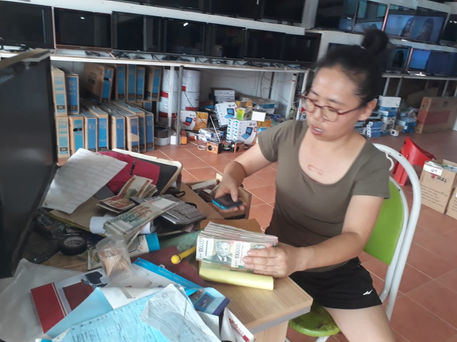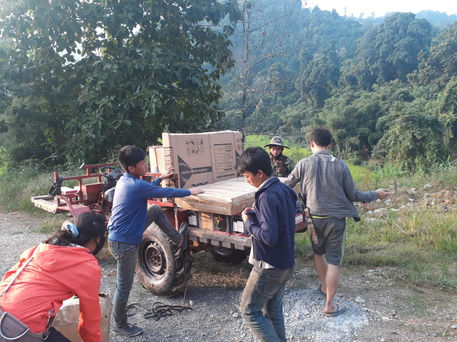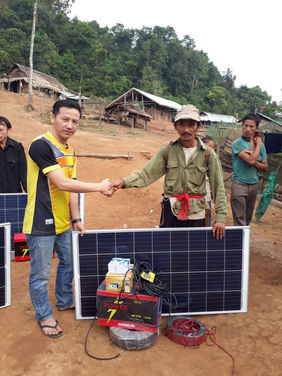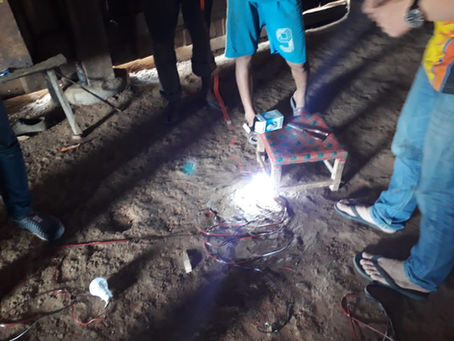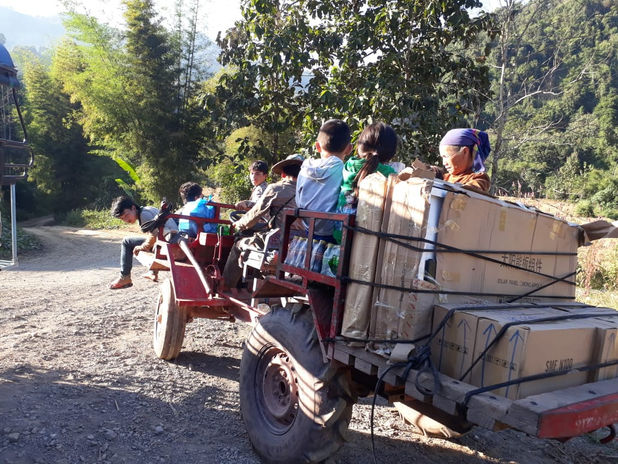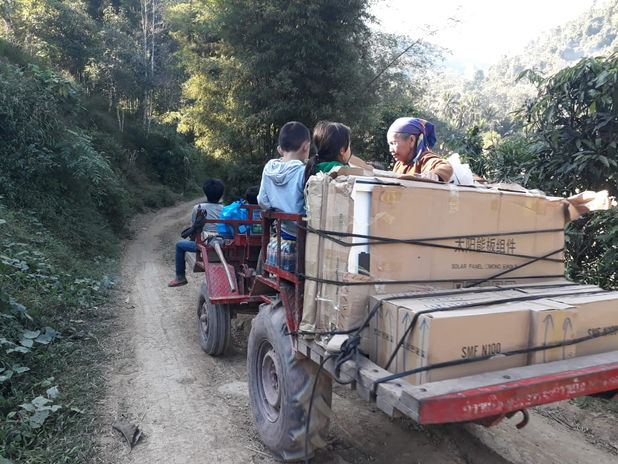Solar generators

Phoumieng is remote and will not be connected to the national power grid in the foreseeable future. At 19.5 degrees north latitude sunset is generally around 6:30 pm year-round making for dark evenings with the only light source being indoor fires. Among other inconveniences, this made it difficult for village children to work on their school homework; indoor fires also add smoke and particulates to the air.
The project funded the installation of forty 120 watt solar panels with batteries and inverters to convert to AC.
Project progress: Three proof-of-concept solar generators were installed on June 23rd, 2018, 15 in early October, 11 in early December, and the final 11 in mid-January, 2019. We had some very generous donations from friends & colleagues, former students – particularly my class of 1980 and IB students from the late 90s, and Cathy Fischer of Boise Idaho who sponsored 4 generators in October. On December 26th, we received a generous donation of $2,450 Cdn to cover the balance of the final 11 generators. Thanks to all donors.
No power tools here ! The photos & video below show the installation of 3 generators on June 23rd, 2018. Bounchan is in the blue & white tee shirt with red arm stripe. Beneath the video is a photo of a villager receiving their generator set from Bounchan (with the yellow shoulder band), and a view of the condition of the 8 km road from Huoy Thak to the village during this part of the rainy season (about mid-May to mid-October).
The October generators (The event has been broken down into 3 parts.)
1. Purchase, transport, and arrival The October 4th, 2018 delivery of 15 generators occurred in 2 parts: a mini-truck took the shipment by ferry across the Mekong and brought it via Pak Long 28 kms to Houy Thak (Hoi Tak) where it was transferred to a "Chinese Buffalo" tractor for the final 8 kms to the village. Click here to follow the route on the map on 2nd page (history buffs, notice Dien Bien Phu in northwest Vietnam on the 2nd map on the 1st page.).
The 1st photo below shows the supplier counting out 100,000 Kip notes totalling 26.5 Million, another 2 M had been given earlier as a deposit. (Total cost about $4,300 Cdn, $3,300 USD). The following three photos show the store – the woman in orange is Noi, Bounchan’s wife. Another 3 photos show the truck – notice the red banner at the bottom of the last one: “Saving elephants is our mission”. The final set shows unloading of the Chinese Buffalo at the village, with a hint of sun. The very last photo shows the remnants of one of the landslides which the villagers cleared by hand – a little heavier than snow !
2. Villagers gather to inspect & receive the generators. The 1st photo below shows all the solar generator kit. Happy & admiring faces in the 2nd photo belong to Jongjar Vang (the man in black, who is assistant chief), and Bounchan Her (in the yellow tee-shirt). Bounchan is explaining the various components in the 3rd through 6th photos, followed by a group photo with Va Xong Thor, in purple, giving a thumbs up. But some of the kids were unimpressed in the next photo.
The final photos show individual presentations: Chue Neng Xong is in the iconic camouflage jacket, village chief at the time Xia Por Vang has a khaki jacket with hat & red sash (the red sash is securing a baby he’s carrying on his back), Jongjar Vang is in black, and Va Xong Thor in purple. I included the final photo because of the cute kids – they are probably one of the recipients’ children. (The village decided that poorer families generally should be given priority for receiving a generator.)
3. Installing the generators. Bounchan and the generator recipients get down to work. In the 2nd photo Bounchan is wearing the yellow & black tee shirt; in two of the later photos he’s wearing a white jacket. FYI: Jongjar Vang, the man in black, is wearing a face mask to avoid transmitting his cold; this was before the pandemic!
December 5th, 2018. Eleven generators were delivered; however, installation was delayed due to Hmong New Year’s celebrations which began on Friday December 7th with the new moon.
The first photo below shows the bill of 20,900,000 Kip; for the generators; notice that the bill has Chinese writing – the merchant is Chinese, Lao printing, and French printing as Laos was a French colony until after WWII. Including transportation, and currency conversion and forwarding, the total cost was $3,500.80 Cdn ($2,614 Usd). The following over-exposed photo was taken in front of the equipment supply store. Three of Bounchan’s kids and his wife Noi are seated in the mini-truck in the next photo. Notice the mountains in the background of the 3 ferry photos.
At Houy Thak (which means “river leech” – so check yourself after swimming) the generators had to be transferred to the Chinese buffalo tractor to cross the stream and navigate the rough 8 km road to Phoumieng. Two of the photos show the same crossing point during rainy season when the stream is a fast-flowing river. A 15 second video shows a portion of the river crossing.
Late afternoon sun in some of the final bucolic photos has a quality almost like Tuscany, and the rainy season is a distant memory. An 8 second video shows the Chinese buffalo tractor chugging along.
Receiving the December 5th generator shipment. As has become the custom, there was a formal presentation of the generator equipment on December 7th. This time Bounchan asked recipients to smile; there’s a very happy villager in the 1st photo. Village chief at the time, Xia Por Vang, is on the right in a camouflage cap and holding a notebook to record the recipients in the 2nd photo. A few of the kids in the 3rd photo are enjoying treats allowed during the Hmong New Year celebrations which started that day; the girls are wearing New Year's outfits.
